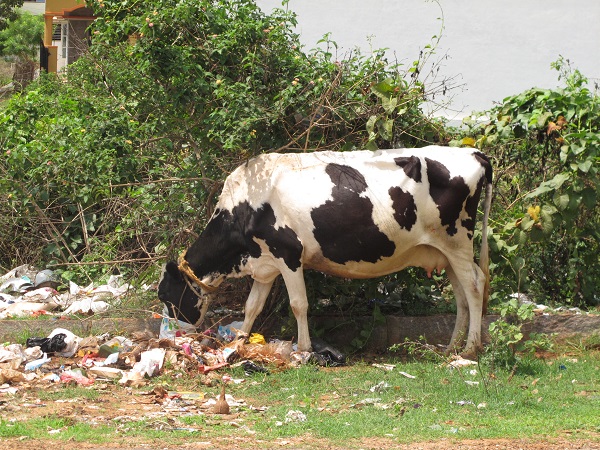

Petroleum fractions have been used alone or as part of external parasite control product mixtures to combat flies and ticks in cattle for many years. In appropriate applications, they may be applied to the skin with few or no harmful efforts on the animals. However, exposing cattle to large quantities of petroleum hydrocarbons or over prolonged periods of time can lead to petroleum product poisoning. This condition results from cattle exposure to petroleum, petroleum condensate, gasoline, diesel fuel, kerosene, crude oil, or other petroleum-based hydrocarbons and can cause production losses, animal health problems, and possible death.
Sources of Petroleum Hydrocarbon Exposure
It is important for cattle producers to be aware of possible sources of petroleum hydrocarbon exposure by their animals and take appropriate steps to reduce or eliminate exposure risk.
Animals may ingest petroleum hydrocarbons out of curiosity, in an attempt to add salt to their diet, when water is not available, or when feedstuffs or water supplies are contaminated.
They can also be exposed to petroleum hydrocarbons through skin contact. In addition, cattle risk exposure when they are confined in areas with poor ventilation where these products are used or stored.
Fuels or other hydrocarbon materials left in open or leaky containers accessible by cattle put animals at risk for petroleum product poisoning. Toxic additives or contaminants such as lead make older formulations of lubricating oils and greases particularly hazardous to cattle. Leaded gasoline, used engine oil filters, used crankcase oil, grease (which may contain 50% lead), and oil field wastes are just some of the petroleum-related items that may contain lead. Cattle will readily drink or lick these oils and greases and can die after only small amounts are consumed. Lead poisoning results in anemia, blood vessel damage, bleeding, kidney damage, liver damage, and tissue oxygen deprivation, ultimately causing sterility, abortion, and death. Crude oil is commonly produced and transported on and across land often used for grazing by cattle.
Cattle exposure to petroleum-derived hydrocarbons may occur at or near petroleum exploration and production sites. Crude oil or petroleum hydrocarbon components of crude oil can exist as liquid, vapor, attached to soil, or dissolved in water. Benzene, toluene, ethylbenzene, and xylene (BTEX) are petroleum components that are particularly soluble, mobile, and toxic and are present in varying amounts in crude oil.
Crude oil releases from accidental leaks and spills such as pipeline breaks, accidental storage tank releases, and tank car accidents can contaminate soil, forage, feed, and/or water. Cattle may then consume these contaminated items or become exposed through other means. Incidental contaminated soil ingestion, contaminated water ingestion, and direct petroleum ingestion are the most likely avenues for crude oil exposure by cattle.
Cattle may consume contaminated soil inadvertently during grazing or purposely ingest saltytasting soil. The amount of contaminated water ingested by cattle varies by animal age, physiological status (pregnancy, lactation, growth, fattening), breed, size, diet composition, and environmental temperature. Viscosity describes the “thickness” of a fluid. Low viscosity fluids such as water flow freely, whereas highly viscous fluids such as honey resist flow more so.
The viscosity of petroleum and petroleum-derived hydrocarbon mixtures influences animal exposure risk. Lowly viscous products such as gasoline, naphtha, and kerosene are more likely to be inhaled into the lungs and may induce vomiting which increases aspiration hazard. These low viscosity products also tend to irritate the trachea and lung tissues. In comparison, more viscous petroleum-based hydrocarbons are less likely to be breathed in and tend to be less damaging to lung tissue.
Signs of Petroleum Poisoning in Cattle
– Petroleum product poisoning damages hide, nervous, respiratory, gastrointestinal, kidney, and liver tissue depending on the route of exposure.
– Skin lesions may develop after repeated or severe exposure. The hide may become dry, cracked, or blistered.
– Acute (severe) bloat can occur shortly after consumption of petroleum hydrocarbons and result in animal death, but does not happen in all cases. It is more common after consumption of highly volatile petroleum products.
– Affected cattle may appear thin or lethargic within 24 hours of exposure and lasting up to two weeks depending on the dose and content.
– Rumen motility (movement) slows within the first day after ingestion. Normal digestive function may not return in some cattle, leading to a chronic wasting condition.
– Low blood glucose (sugar) levels are also sometimes found several days after ingestion.
– Manure may not be affected until several days after ingestion and can include oil up to two weeks after petroleum product consumption. Manure pats may appear excessively dry. Ingestion of large volumes of crude oil results in vomiting and aspiration into the lungs.
– Nervous system damage is usually associated with inhalation of petroleum-based products.
– Excitability, depression, shivering, head tremors, vision disruption, and incoordination can arise following lung absorption of petroleum hydrocarbons. Yet the most serious consequence of breathing in these hydrocarbons is pneumonia.
– Severe pneumonia, coughing, rapid shallow breathing, reluctance to move, head held low, weakness, dehydrated appearance, and oily nasal discharge can be seen in animals that breathe in highly volatile mixtures.
– Death often follows within days. Low white blood cell counts followed by an increase in white blood cell numbers as well as changes to other blood components occur with pneumonia onset.
– Reproductive losses, production losses, and animal death are possible outcomes with petroleum hydrocarbon exposure. Reproductive and developmental effects have generally been reported at higher doses than those reported for other health effects.
Therefore, If petroleum product poisoning is suspected, consult with a veterinarian immediately to confirm this and to begin a treatment program. Providing detailed information on petroleum product exposure, animal production conditions, and signs of illness to animal health professionals can help to address the problem more quickly and effectively.
 Contact Jaguza Support
Contact Jaguza Support